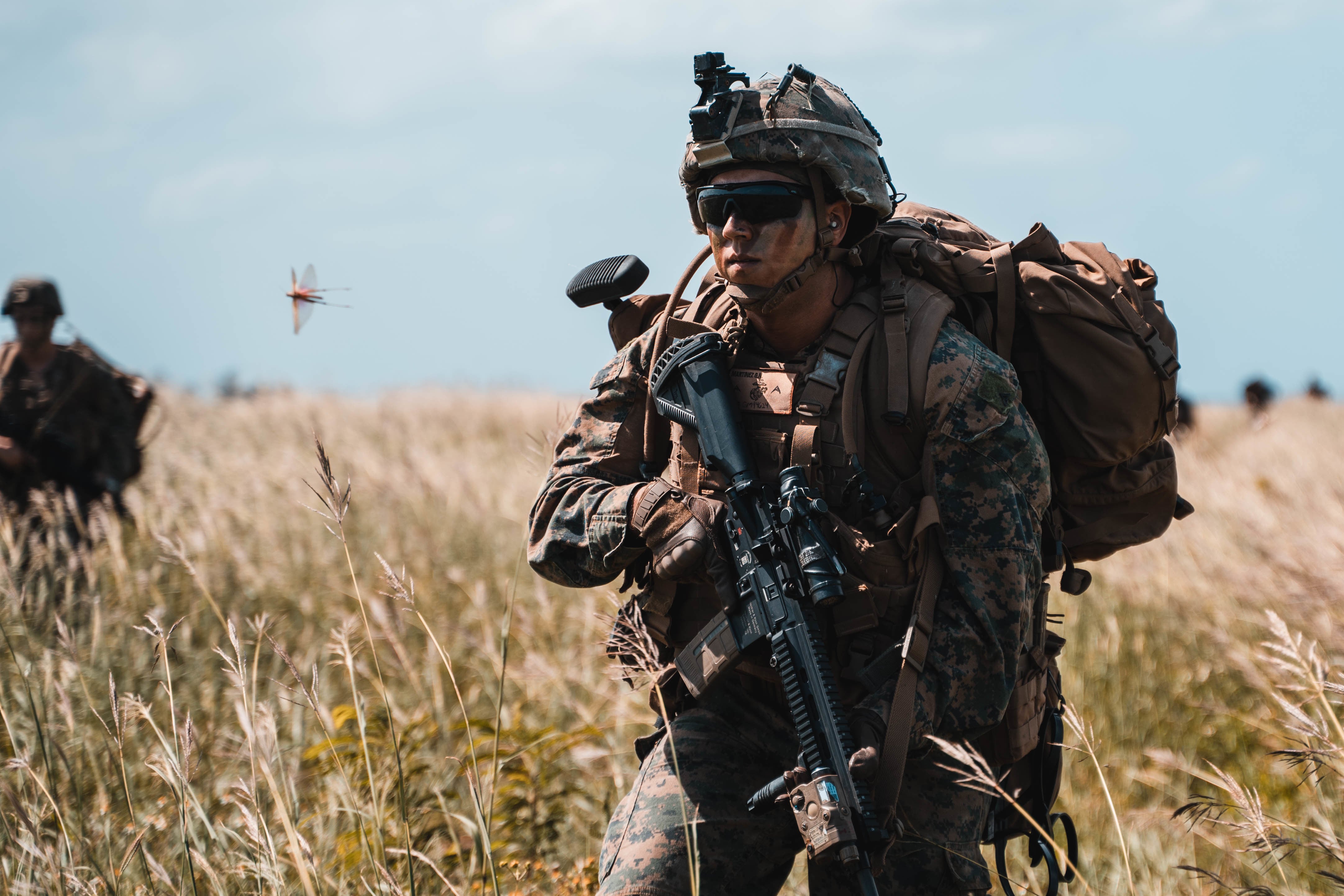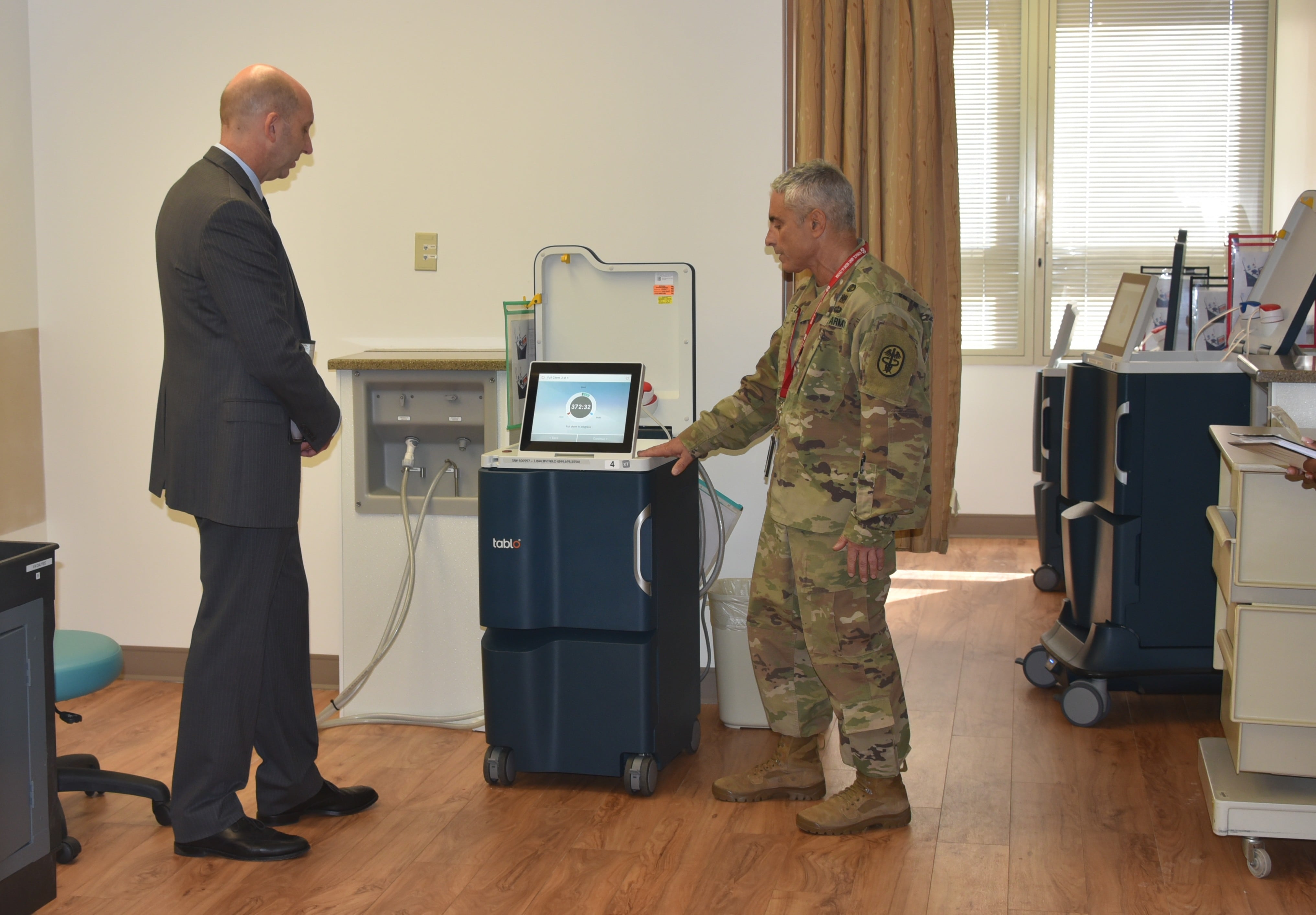In the not too distant future, on a dark night in the middle of the South Pacific, a small team of reconnaissance Marines, accompanied by a handful of special forces airmen, drop from 10,000 feet on a small atoll held by the enemy.
A firefight quickly starts.
The Marines focus their fire on the enemy, while Navy corpsman and Air Force guardian angel pararescue jumpers rapidly treat any battlefield casualties. An Air Force combat controller calls in a quick air strike, silencing the enemy as the U.S. unit successfully takes the small atoll.
While the Marines provide security, the combat controllers quickly get to work, ensuring the flat ground on the island is safe to land a C-130 carrying a single High Mobility Artillery Rocket System launcher.
Within minutes the combat controllers land the C-130 and the HIMARS rolls out the back, ready to launch a rocket volley deep behind enemy lines.
Immediately after the launch Marines and airmen load up in the C-130 and leave the battlefield.
The military concept is called High Mobility Artillery Rocket System Rapid Infiltration and has been in development for years. For at least some reconnaissance Marines, it means working closely with Air Force special forces.
The concept also fits neatly into Marine Corps Commandant Gen. David Berger’s plan for the future Marine Corps, which sees the Corps facing off against near-peer adversaries using a mix of long range fires, cyberattacks and small unit raids, opening up the battlefield for the rest of the joint force.
To ensure these concepts work when called upon, Marines with the 3rd Reconnaissance Battalion based out on Camp Schwab in Okinawa, Japan, have been working with the Air Force’s 320th Special Tactics Unit based on Kadena Air Force Base, also in Okinawa, Japan. They have been training with each other since at least 2015, Maj. Kurt Stahl, a Marine Corps spokesman, told Marine Corps Times.
RELATED

The most recent cross-training event, which took place in November 2020, saw the two units work together to complete 3rd Recon’s Marine Corps Combat Readiness Exercise, or MCCRE, at the Jungle Warfare center on Okinawa, Japan, Stahl said.
“The relationship is, is the most essential foundation for the joint execution of a no notice or short notice crisis,” Dan Schilling, a former combat controller turned Air Force special tactics officer, told Marine Corps Times.
“If you don’t have that exposure and relationship and trust because that’s where it really comes down to that’s the commodity here, man you’re starting from zero. But if you got it … you just know it’s going to flow,” said Schilling, the author of “Alone at Dawn” ― the story of Medal of Honor recipient and combat controller Tech. Sgt. John Chapman.
Recon Marines are working with Air Force pararescue jumpers, known as PJs, along with combat controllers.
“We noticed between force recon and the special tactics squadron that we have a lot of mirror capabilities and we do a lot of the same type of training,” Maj. Joshua Chambers, the 3rd Recon operations officer, told Marine Corps Times.
“We wanted to kind of share with each other had to offer as far as, procedures, tactics and how can we make each other stronger,” he added.
The PJs specialize in providing emergency medical care in hostile environments with a specialty in rescuing service members from hard-to-reach locations.
Between the PJs and the Navy corpsman assigned to the recon unit, the Marines have some of the best and diversely trained emergency medical care in the military, Schilling said.
While the PJs help round off the medical care available in the recon unit, the combat controllers provide the unit with a capability they can not find within the Marine Corps itself.
While the combat controllers are trained at calling in airstrikes, they bring to the table one skill that is not organic to the Marine Corps: They are some of the only military personnel capable of joining special operations forces on forward deployed missions, identifying remote landing strips and providing the ground-based communication necessary to land planes on these strips.
“The Marine Corps organically has aircraft or air traffic controllers, but none of them are special insert capable,” Chambers said.
Standard infantry Marines also are capable of completing the High Mobility Artillery Rocket System Rapid Infiltration mission without the Air Force special forces attachment, Stahl said in a follow-on email.
But they may be missing out on the robust capabilities of the combat controllers.
The unique combination of skills led Schilling to call these airmen “deadliest individual to walk a battlefield in the history of human warfare.”
“It is a choreograph of death and these guys orchestrate that choreography, like no one else,” Schilling added.
While there are likely Marines in the recon team who would contest that assertion, they are appreciative of the extra capabilities having a combat controller on missions provide.
“There are things they do very well and there are things we do very well,” Chambers said. “By sharing our experiences and our knowledge we get a different perspective of things … overall that helps build a better team and makes each other better.”
The Pacific Marines are not the only ones working with the Air Force to improve their capabilities.
In 2018 Special Purpose Marine Air-Ground Task Force – Crisis Response – Africa (SPMAGTF-CR-AF) started working with PJs in an attempt to improve the Corps’ ability to rapidly respond to emergencies in their area of operations.
“The inclusion of these highly qualified airmen provides SPMAGTF-CR-AF with dedicated technical rescue personnel, as well as field and in-flight paramedic capabilities,” Maj. Adrian Rankine-Galloway, a spokesman for U.S. Marine Corps Forces Europe and Africa, told Marine Corps Times in 2019.
While the focus for 3rd Recon may be on the improved offensive punch the combat controllers provide them, the PJs capabilities may be part of the solution to the problem of casualty care on a widely dispersed battlefield.
Chambers said the relationship between the recon unit and the PJs could extend to standard Marine Corps infantry on a future battlefield that’s spread out across thousands of miles in the Pacific.
Berger said distributed operations against a near-peer opponent creates challenges to Marine Corps casualty care, in a September 2020 Defense One online expo.
“We’re used to a golden hour, in Afghanistan or Iraq … you get knocked down, you’re shot in the leg, boom, you’re in a level three within 60 minutes,” Berger said.
“That’s not reasonable when you’re fighting a distributed fight. So that means we have to have a medical capability more forward than we did before. More distributed has to be the medical capability. We need different medical capability because you may not get to a level three for four hours or four days.”
While attaching PJs to every small Marine force may not be reasonable, giving the Corps have a basic understanding of how another service performs casualty care in fare away places can provide a valuable lesson for Marines.
“It’s not about the Marine Corps or the Air Force its about the joint force and how we can make each other better for the long game,” Chambers said.
Editor’s note: More context about which Marines are capable of the High Mobility Artillery Rocket System Rapid Infiltration mission was added after a follow-on email from Maj. Kurt Stahl, the spokesman for 3rd Marine Division.





